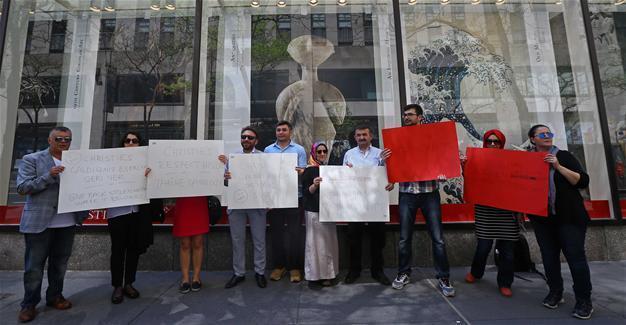Smuggled Anatolian idol sold in US
NEW YORK

Guennol Stargazer, a 5,000-year-old Anatolian marble female figure that was smuggled from Turkey, was sold for $14,5 million at a New York auction on April 28.
The sale was protested by Turks who gathered outside the auction house.

The Guennol Stargazer, which dates back to the third millennium B.C., is regarded as one of best examples of Kiliya-type Anatolian marble female idols.
The historic idol, which Turkey has initiated legal action for the return of, was sold at the New York center of the Christie’s Auction House at the Rockefeller Center.
The Guennol Stargazer, which was put on sale in The Exceptional Sale 2017 auction of Christie’s, found a buyer for $12.5 million, reaching $14,471,500 million including all costs.
Speaking to reporters in Istanbul before the auction, Turkish Culture Minister Nabi Avcı criticized the sale of the smuggled item.
“We’ve taken steps to stop the sale of this work of art and inform the possible recipient that it was smuggled from Turkey,” Avcı said.
He also said the artifact was “part of a pillage that has been ongoing for 200 years.”
The ministry had contacted Christie’s to request that the statuette be removed from the auction and returned to Turkey. The diplomatic initiative, however, was rebuffed, resulting in the ministry initiating legal action.
The ministry also published a full-page letter in the New York Times to demand the repatriation of artifacts smuggled out of the country.
“The Ministry of Culture and Tourism of the Republic of Turkey extends its appreciation to the institutions and individuals that have helped to repatriate lost artifacts to their Anatolian origins,” the ministry’s open letter to the New York Times stated.
“The good faith shown in each instance is an example of how countries and cultural communities can work together to preserve the archaeological record,” it said.
“The trade and sale of cultural assets are governed by international conventions and domestic legislations, like UNESCO’s global ‘Convention on the Means of Prohibiting and Preventing the illicit Import, Export and Transfer of Ownership of Cultural Property’ in 1970, as well as Turkey’s national Asar-1 Atika Regulation of 1884 that prohibits the export of any newly found or yet-unearthed artwork,” it added.
“In the spirit of cultural cooperation, we embrace continued collaboration with the arts community to discover the archaeological context of such historic works, and have good faith that any current or future custodians of Anatolian relics will likewise work with the Turkish Ministry of Culture and Tourism to return such pieces to their ancestral homes,” it said.
No payment for 60 days According to a U.S. court ruling, the buyer will have to wait for 60 days before receiving the idol, meaning Christie’s will not be able to receive payment and deliver the artifact for two months.
Before the auction, Christie’s management was expected to inform potential buyers that Turkey claims the artifact.
The president of Christie’s Auction House, Jussi Pylkkanen, said that because of the court ruling money would not be received from the buyer for 60 days and the artifact would not be given to the buyer in this process.
The 23-centimeter figure had an estimated sale price of $3 million.
With an opening price of $2 million, the auction for the artifact took 25 minutes, the longest sale in the auction. There were three people on the phone who wanted to buy the idol and it was sold to a collector, whose name has not been identified.
Speaking to state-run Anadolu Agency, a spokesman for Christie’s Auction House said Ankara’s attempt to stop the sale was rejected by District Judge Alison Nathan and the auction was held.
The artifact, which takes its name from its first owner, the Guennol family from the Wales, has been out in the auction by a New Yorker private collector.
The artifact was borrowed from the Guennol Collection between 1966 and 1993, and was displayed for the first time at the New York Metropolitan Museum of Art. It was also on display at many museums in Europe and the U.S.
The Kilia-type figure, dating back to the Later Chalcolithic and Early Bronze Age, was found in the Kilya Cove in the northwestern province of Çanakkale.
Turks protested the sale
A group of Turks, who gathered in front of the auction house, protested against the sale of the artifact.
Reading a press release, the group asked for it to be returned to its home and opened banners reading, “Shame on you Christie’s” and “Artifacts are the shared treasure of humanity.”
“We are here to protest the sale of smuggled artifacts from Anatolia at the Christie’s Auction House. As Turkish Americans living in the U.S., we think these artifacts should be returned to their homeland, Anatolia,” said Turkish American Businessmen Association (TAAB) President Mustafa Tuncer at the protest.

